ISSN ONLINE(2278-8875) PRINT (2320-3765)
ISSN ONLINE(2278-8875) PRINT (2320-3765)
A. Khouya1, A. Draoui2, B. Zeghmati3, S. Abide3, X. Chesneau3
|
| Related article at Pubmed, Scholar Google |
Visit for more related articles at International Journal of Advanced Research in Electrical, Electronics and Instrumentation Engineering
A numerical study is performed in order to analyse the effect of combined microwave and convective drying on the wood rheology behaviour. The stress model takes into account the free shrinkage, elastic deformation, viscoelasticity and mechanosorptive creep. Stress equations were solved using an implicit finite differential scheme and Thomas algorithm. Results showed that, combined convective and microwave drying reduce the drying time of wood and increasing the drying efficiency. It was found that the moisture content of wood below the fiber saturation point affect the drying stress and there was a significant effect between the drying condition and the mechanical properties of wood. The variation of moisture content during drying intended to produce a mechano-sorptive creep that is able to reduce drying stress. The stress model is used to optimize drying process and to effectively relieve the residual stresses after drying.
Keywords |
| Convective drying, Wood, Microwave, Shrinkage, Viscoelasticity, Mechanosorptive creep. |
INTRODUCTION |
| During drying, strain and stress appear in wood due to free shrinkage which result from moisture movement and temperature variations. It has also been observed that the mechanical behaviour of wood is depending on its moisture migration, an effect known as mechano-sorptive and viscoelasticity creep. Many investigations on wood rheological have been devoted since several decades [1]-[4]. These investigations used finite element method or control volume method, to solve transfer equations in order to analyze the mechanical behaviour of wood during drying. |
| Hanhijarvi and Hunt [5] performed creep tests on mechanical behaviour of wood to yield the effect between mechanosorptive and viscoelasticity deformation. They showed that for constant ambient relative humidities, the viscoelasticity creep is depending on the mechanosorptive creep accumulation during cyclic variation of environmental humidity. Beyond, the mechano-sorptive creep accumulations induce a decrease of the viscoelasticity deformation. |
| Turner et al. [6] carried out a numerical investigation of combined microwave and convective heating during drying of wood. These governing equations were discretized using the control volume method in order to analyze the effect of microwave propagation on drying time of wood. They showed that combined microwave and convective drying process reduce the drying time, increase the internal pressure of wood and provide high density for hardwood. |
| Hanson and Antti [7] studied the effect of temperature on wood during microwave and conventional drying. Results showed that there is significant effect in wood boards between the microwave and conventional drying method. Vongpradubchai and Rattanadecho [8] analyze the influence of microwave heating on the mechanical properties of wood using the conventional and microwave heating method. They showed that the microwave heating reduces the drying time, energy consummation and offers better mechanical proprieties with high strength than conventional one. |
| A numerical study is performed to analyse the effect of temperature and moisture content on the mechanical behaviour of spruce during convective drying [9]. It is noted that during the post-kiln storage period, the free shrinkage induced by moisture movement have a significant effect on the boards stress. The drying time of Spruce is proportional to the board thickness during the first drying period and to the thickness squared during the second drying period, controlled by diffusion process in hygroscopic field of wood [10]. |
| Drying wood using microwave energy is not very common, but could be a complement to convective drying in order to reduce drying time, consumption energy and preserved the quality properties of wood. If it is difficult to study experimentally the drying stress induced by moisture content during combined convective and microwave drying, then the mathematical modeling can be used to describe this process. The objective of the present work was to propose a wood drying model based on classical rheology model in order to analyze the stress and strain in one direction. This model takes into account thermo-physiques and mechanicals propriety of wood boards in longitudinal, radial and tangential direction. Such model is computationally drying time consumption, stress and strain through the timber board thickness in order to optimize the procedure of wood drying process. |
MATHEMATICAL FORMULATION |
| The analytical model for convective and microwave drying of wood was done based on the following assumptions (fig 1): |
| - The heat and mass transfer are in one dimensional; |
| - The air flow is laminar; |
| - The heats transfers by radiation are not considered and heat transfer is by conduction and convection only. |
| - The incident microwaves are assumed to be perpendicular to the board surface; |
| - The deformations are small; |
| - The curvature radius depends only on the board stress. |
A. Moisture and temperature transfer model |
| The heat and moisture transfer in a slap wood of thickness 2e are written in the (ox) referential: |
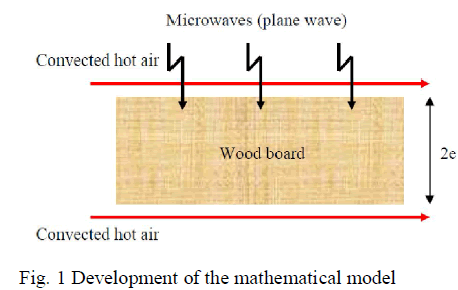 |
| Mass transfer: |
 |
| where X = X(x, t) is the moisture content; DR the mass diffusion coefficient in the radial direction. |
| Heat transfer: |
 |
| where T = T(x, t) is the temperature; ρ, C, λR are respectively the density, the specific heat and the thermal conductivity of the wood. Q is the microwave term source. |
 |
Microwave term source (Q): |
| The energy supplied by microwave is absorbed by the wood. The volumetric heat Q input during drying of wood depends on its dielectric properties, the distance from the surface, the frequency and the intensity of microwave applied. The dielectric constant and loss factor are functions of moisture and temperature in board [6]. In this work, the incident microwaves are assumed to be perpendicular to the board surface and decrease exponentially according to the Lambert’s law [12]: |
 |
| where x is the depth from the surface along the axis direction, Q(x) is the microwave power dissipated at depth x, Q0 is the incident microwave flux at the surface of wood and α is attenuation constant expressed as [12]: |
 |
| where λ is wavelength in vacuum and tanδ is the loss tangent derived from a material's complex permittivity. The complex dielectric constant is given by: |
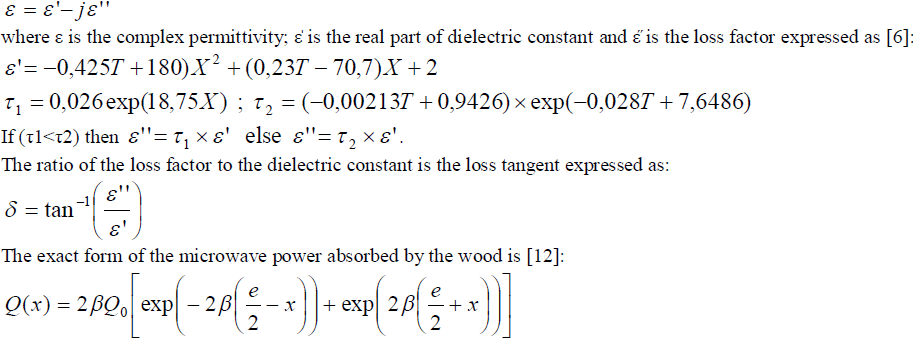 |
B. Stress transfer |
| `During drying, internal stress within the wood is induced by differences in the shrinkage coefficient, for moisture content inferior to the fiber saturation point. The stress induced elastic strain εe, free shrinkage εr, viscoelasticity strain εve and mechano-sorptive strain εms. A constitutive equation for one-dimensional stress model can be written as follows (Fig. 2): |
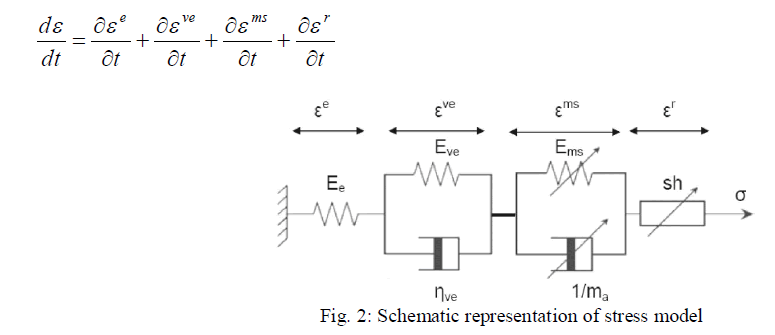 |
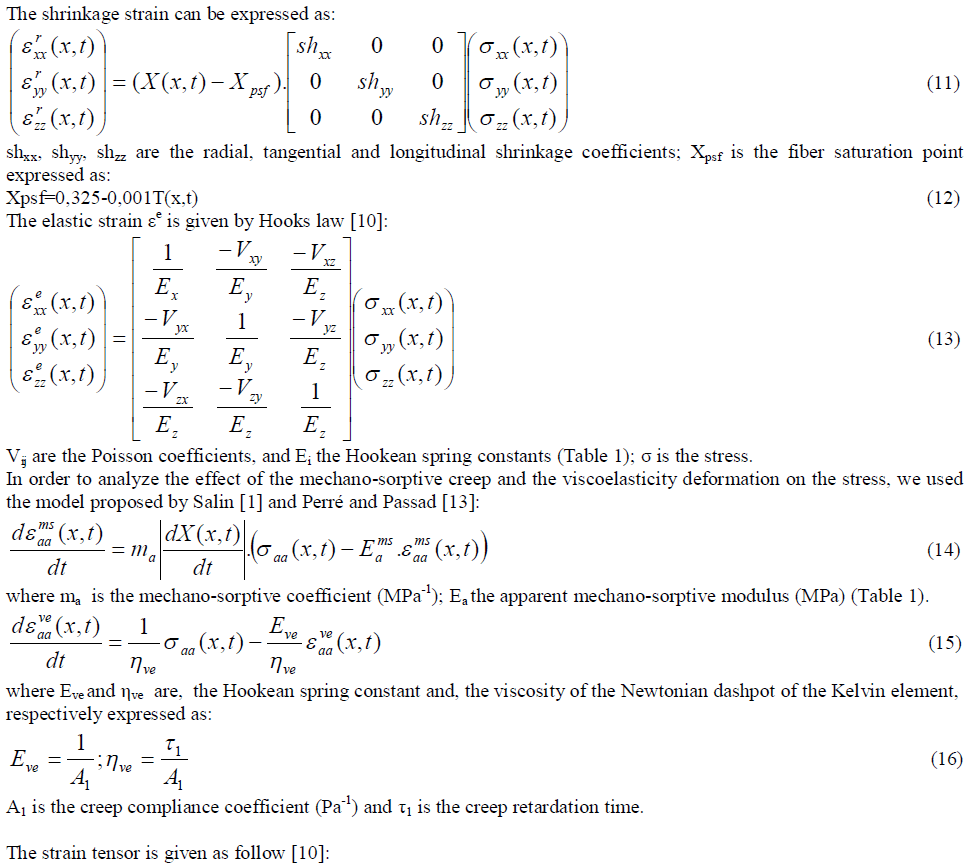 |
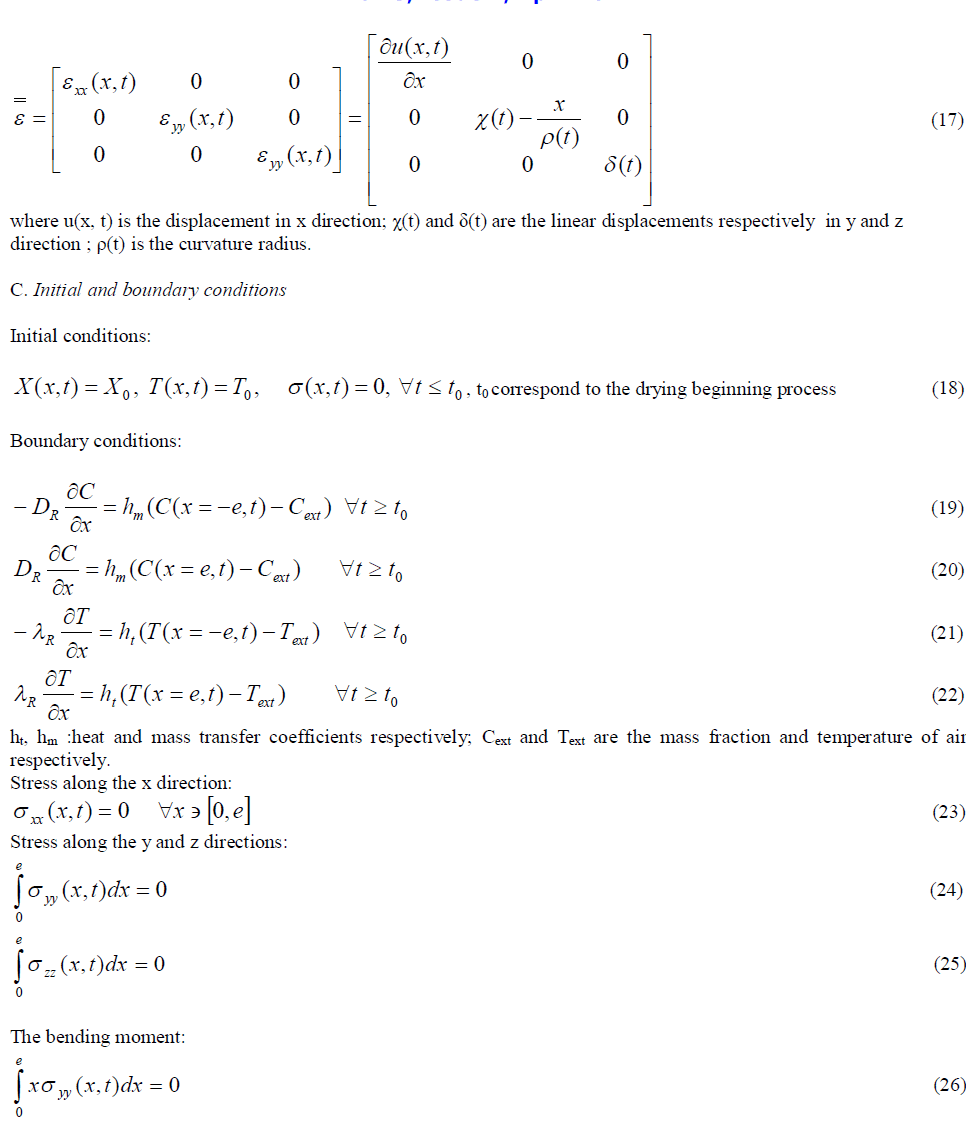 |
Numerical procedure: |
| Transfers and stress equations associated to boundaries conditions are solving using an implicit numerical scheme and Thomas algorithm for heat and moisture transfer and Gauss Jordan algorithm for stress equations. The discretized stress constitutive equations are: |
Boundary conditions: |
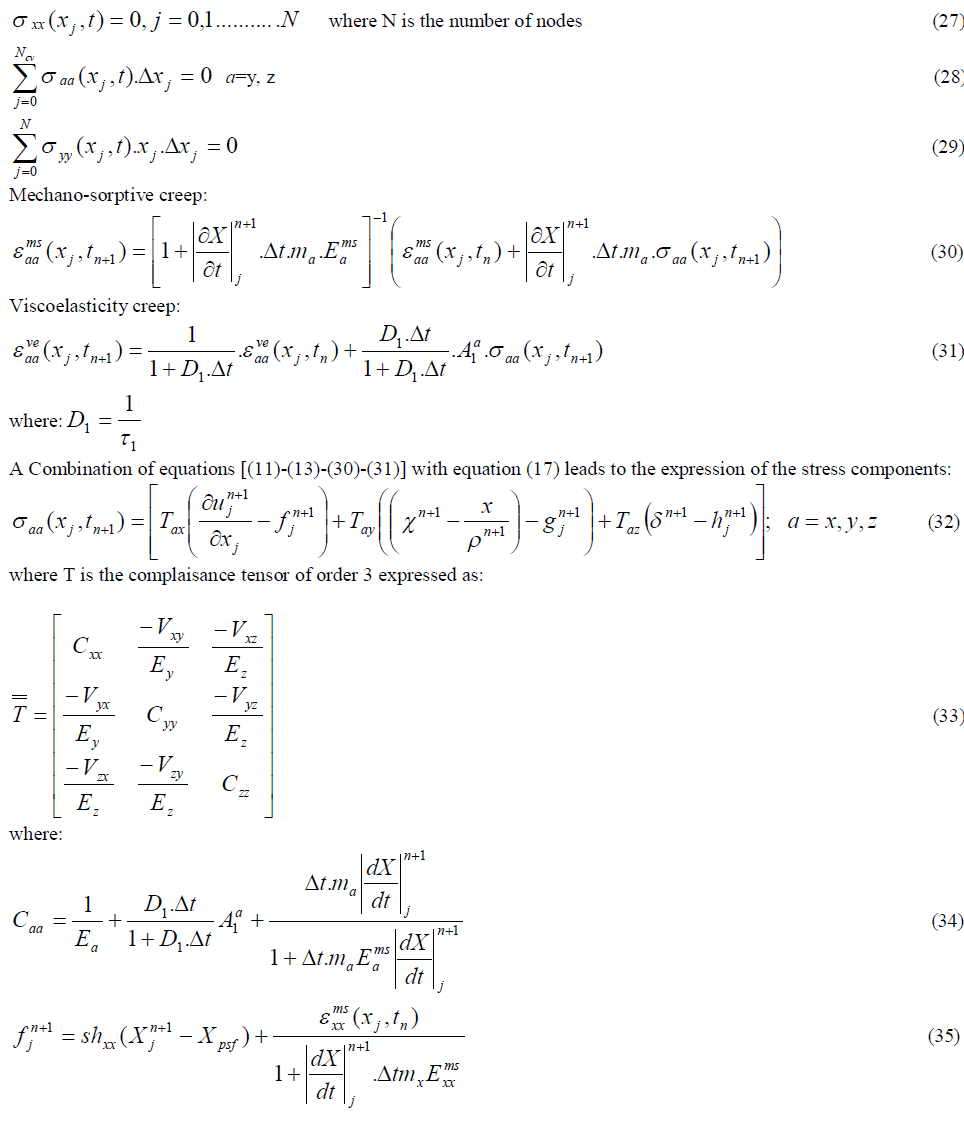 |
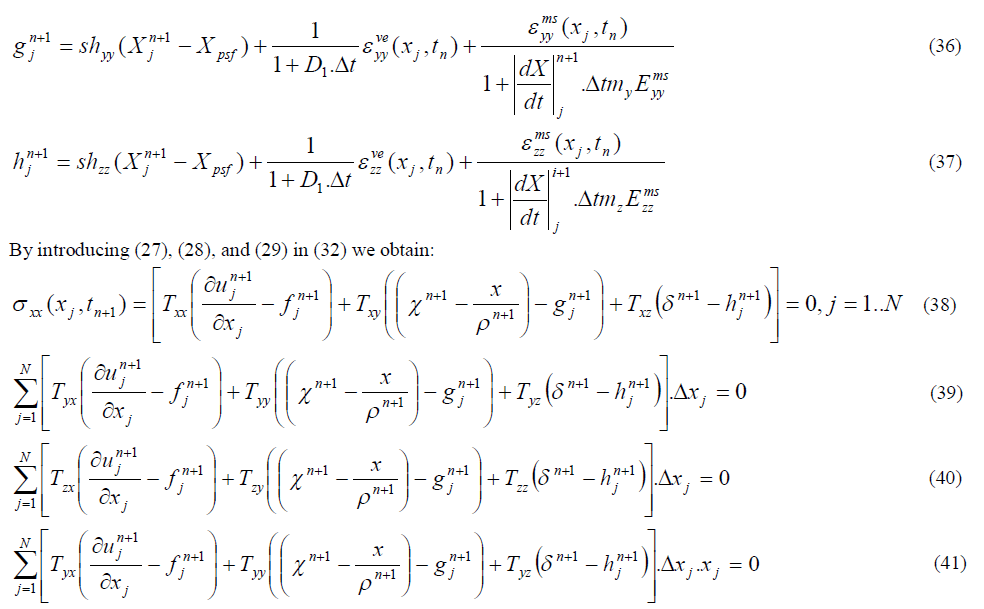 |
| We obtain an algebraic system of N+3 linear equations. The discretized equations can be rewritten in matrix form A.X = B. The vector X, indicates the unknown of the problem, it contains the displacement field in the board and the curvature radius. |
VALIDATION OF DRYING MODEL FOR CONVECTIVE DRYING |
| In order to validate ours numerical code, we compare ours results with those of Rémond [9]. The wood board has a thickness of 30 mm and an initial moisture content equal to 0.7 kg water.kg dry solid-1. The air dry bulb temperature is supposed to be equal to 65°C and the mechanical properties values are reported in the table 1. |
 |
| Fig 3 shows the average moisture content versus time of a 30 mm thickness during convective drying of Spruce. We note only, the existence of the falling drying rate period. So, the diffusion process is the most likely physical mechanism governing the moisture movement in the wood board. The discrepancies between our results and those of Rémond are of order 5 %. For the stress evolution during time, our results are in good agreement with results of Rémond (fig 4). In fact, the discrepancies are about 3 % for the surface stress and 5 % for the core one (stress in the center). It is noticed that the surface tensile stress increases continuously with time, to reaches a maximum value equal to 2.3 MPa then decreases until a value equal of -2.5 MPa. Concerning the core drying stress, the compressive stress decreases to a minimum value of -1.1 MPa. It is found that the core of spruce is under tension after 48 hours of drying and stress increases continuously until a constant value of 0.5 MPa. |
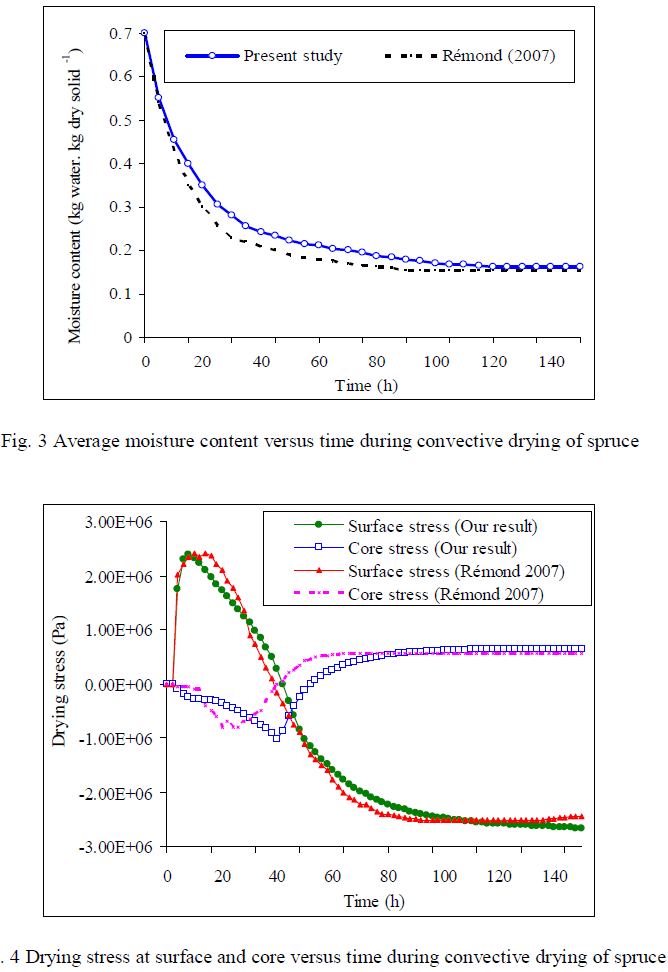 |
RESULTS AND DISCUSSIONS |
| Fig 5 represents the effect of microwave heating on drying times and drying stress for various incident microwave flux. We assumed that the thickness of board is the dimension parallel to the direction of microwave heating propagation. The board has a thickness of 30 mm, length of 1000 mm and a larger of 100 mm. The initial moisture content has 1.2 kg water.kg dry solid-1, and the drying bulb temperature equal to 45 °C. The microwave irradiated area of wood has a dimension of 0.1 m2 which supplies that the incident microwave on the board surface is 10000 W.m-2 with a power of 1000 W generated from the microwave heating. The operating frequency was 2.45 GHz. During the convective and microwave heating, the drying time is required to reduce the water from initial moisture content to desired final moisture product. Microwave energy injected in the material is absorbed by water molecular in wood cell because the value of dielectric loss factor in sapwood is superior to dry wood one (hardwood). It is showed that the drying time decreases as the microwave power increases, because the drying velocity is proportional to the difference between the pressure of vapor inside the material and the drying air. The increases of the microwave power induce an increase of temperature within the board and consequently the steam pressure at surface decreases. For drying case with an incident microwave equal to 10 KW.m-2, the drying time reduce from 100 hours in the case drying without microwave to 20 hours. These results can be explained by the penetration depth and loss factor of material which depends of the injected microwave power, the variation of the moisture content and the drying air temperature. The drying is finished when the temperature and the moisture content of the board attain respectively the outside air temperature and the equilibrium moisture content. These results are in good agreement with results of Turner and al. [6]. |
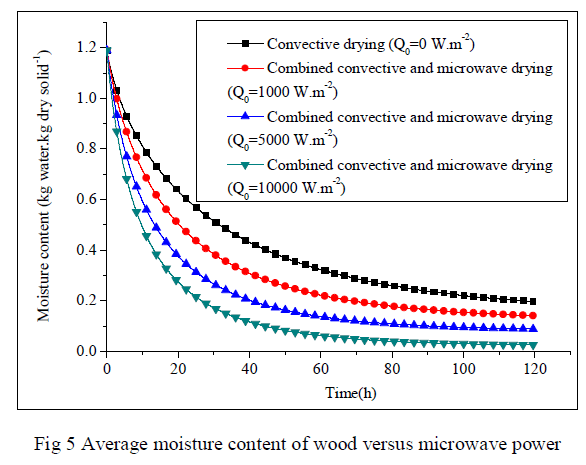 |
| The effect of microwave heating on drying stress induces by moisture content variation is shown in fig 6. The stress and the shrinkage occur when the moisture content of the board attain the fiber saturation point. It is found that the magnitude of the stress decreases as the microwave energy increases. This decreases of the magnitude led to an increases of the differences between the maximum and minimum stress. This is due to the absorbed microwave energy which uniformly irradiated heat from the inside of board resulting in temperature at center being higher than other position. An increase in the temperature level induces stresses and strains in the boards which due to wood thermal proprieties such as thermal expansion and fiber saturation point coefficient. We showed that the mechano-sorptive strain at surface increases as the injected microwave power increases (fig 7), because it’s depend on the drying rate which increases as the temperature increases. For a case of 10 KW.m-2 incident microwave power, we observe that after 8 h of drying the surface stress is in tension and with the mechanical equilibrium, the core of the board is in compression. This is because as the surface moisture content dries below the fiber saturation point, the board shrinks and the water is reduced in the bound of the cell wall. The core of the board not shrinks because its moisture content is still above the fiber saturation point. This leads to a stress within the board. The board attains its final moisture content after 30 hours and the stress reversal due the mechano-sorptive effect is exhibited. Therefore, the surface stress is in compression and core stress in tension. The analyze of these results show that, for convective drying case, the maximum surface stress is equal to 3.2 MPa and the minimum core stress is equal to -2 MPa. These values are inferior to those obtained using an incident microwave of 10 KW.m-2. In fact the maximum surface stress is equal to 4.5 MPa and the minimum core stress is equal to -2.2 MPa. Residual stresses exist within the board at the end point of drying. This is due to the mechanicals properties of wood and moisture content gradient through the thickness. However, for high quality products, a treatment operation of the wood mechanical propriety can reduce these residual stresses to an accepted one [14]. |
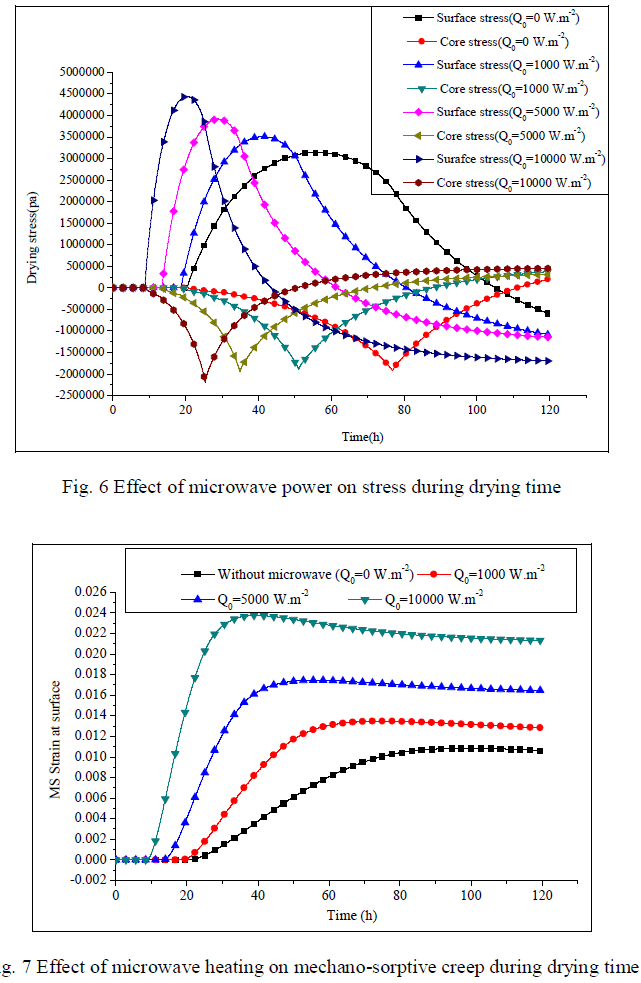 |
| The effect of board size on the stress induces by drying assuming constant incident microwave flux of 10 KW/m2 is shown in fig 8. It is showed that, the magnitude and the amplitude of the stress increases as the board thickness increases, because the moisture content profiles are steeper for great thickness and the drying time required for drying board is longer which should result in more time for the viscoelasticity creep to reduce the stress level. Turner [6] founded that the effect of the microwave process increases as the board thickness is greater than the penetration depth of the microwave. This due to the volumetric heating generating high interaction between the water and wood material resulted in boiling and bubbling of the samples. |
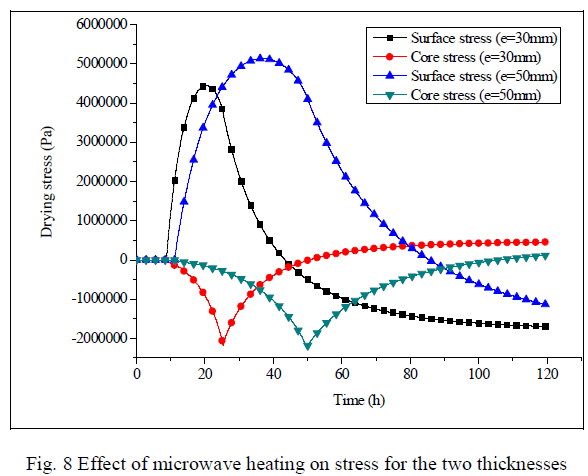 |
| The effect of mechanosorptive creep (MS) on drying stress at surface and core of the board during combined convective and microwave heating assuming constant incident microwave flux of 10 KW/m2 is shown in fig 9. We observe that the board is in tension, and its core is in compression during the first step of drying process. The maximum tensile stress induced by the viscoelasticity creep when the mechanosorptive creep is deactivates reaches 10 MPa. It is noted that the combination of the two effects (mechano-sorptive + viscoelasticity creep) leads to a decreasing of the board stress. So, the mechano-sorptive proprieties allow important creep at the beginning of the drying process which reduces the core stress which decreases until a minimal value then increases continuously to reach a constant value. We note a different evolution of the surface stress which increases to attain a maximum value and decreases until a minimal value at the end point of drying process. |
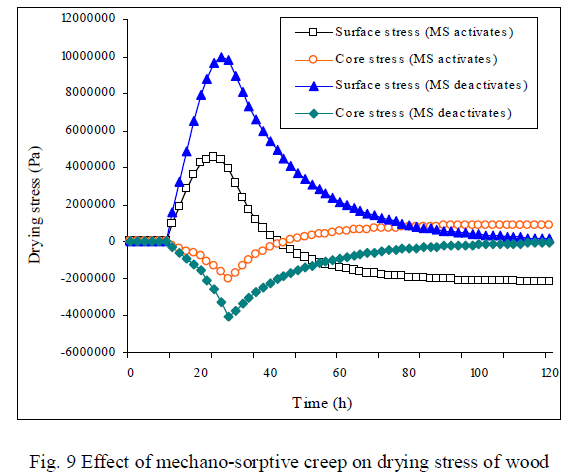 |
CONCLUSION |
| A numerical study of the thermo-hygro-mechanical behaviour of a wood board is performed to predict moisture content, strain and stress during combined convective and microwave drying. A stress reversal phenomenon is observed between tensile and compressive stresses. Residual stresses within the board exist at the end point of drying. The activation of the mechano-sorptive creep properties of wood that plays an important role to relax the residual stresses can be used to reduce drying stress. Nevertheless, there are hard differences in the drying stress, especially when stresses were compared in the center versus surface of wood. The results showed that: |
| - The moisture content induce stress during drying process below the fiber saturation point ; |
| - The increase in microwave power level decreased the drying time; |
| - As the thickness of the wood slab increases the time for complete drying of the spruce slab increases; |
| - The mechano-sorptive creep reduce the stress during drying ; |
| - Combined convective and microwave power heating reduce the drying time of wood timber, the magnitude and duration of thermal stress. |
References |
|